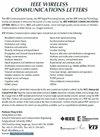在无赠予网络中通过基于模型的深度学习进行干扰估计
IF 5.5
3区 计算机科学
Q1 COMPUTER SCIENCE, INFORMATION SYSTEMS
引用次数: 0
摘要
这封信提出了一种使用基于模型的深度学习(DL)框架估计无授权接入网络中干扰分布参数的新方法。我们的方法将分析模型的精度与深度学习算法的适应性相结合。具体来说,我们采用了一个分析模型来生成标记数据,这增强了深度学习模型估计干扰水平的能力。通过广泛的验证,我们证明了我们的方法准确地估计了各种场景中的干扰,包括模型训练期间未涵盖的操作区域。此外,我们的方法还估计了干扰节点的空间密度,使其成为无授权接入网络中干扰管理的重要工具。该方法为提高干扰估计精度提供了一种鲁棒的解决方案,有助于在无授权访问方案中介质访问控制(MAC)和物理层的决策。本文章由计算机程序翻译,如有差异,请以英文原文为准。
Interference Estimation via Model-Based Deep Learning in Grant-Free Networks
This letter presents a novel approach for estimating interference distribution parameters in grant-free access networks using a model-based deep learning (DL) framework. Our method integrates the precision of analytical models with the adaptability of deep learning algorithms. Specifically, we employ an analytical model to generate labeled data, which enhances the deep learning model’s ability to estimate interference levels. Through extensive validation, we demonstrate that our approach accurately estimates interference across a broad range of scenarios, including operating regions not covered during the model’s training. Moreover, our method also estimates the spatial density of interfering nodes, making it a valuable tool for interference management in grant-free access networks. This methodology offers a robust solution for improving interference estimation accuracy, aiding decision-making at the Medium Access Control (MAC) and physical layers in grant-free access schemes.
求助全文
通过发布文献求助,成功后即可免费获取论文全文。
去求助
来源期刊

IEEE Wireless Communications Letters
Engineering-Electrical and Electronic Engineering
CiteScore
12.30
自引率
6.30%
发文量
481
期刊介绍:
IEEE Wireless Communications Letters publishes short papers in a rapid publication cycle on advances in the state-of-the-art of wireless communications. Both theoretical contributions (including new techniques, concepts, and analyses) and practical contributions (including system experiments and prototypes, and new applications) are encouraged. This journal focuses on the physical layer and the link layer of wireless communication systems.
 求助内容:
求助内容: 应助结果提醒方式:
应助结果提醒方式:


